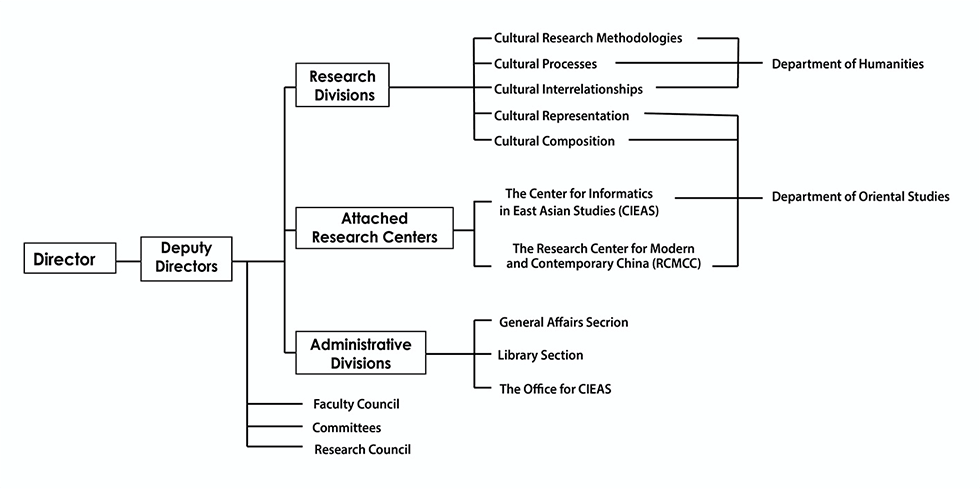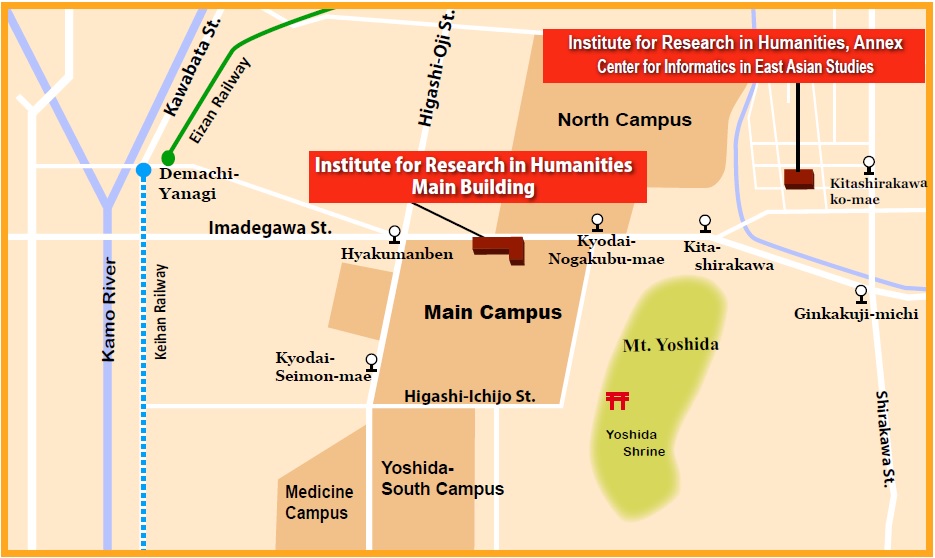Organization
1. Organizational Structure
In April 2000 the Institute for Research in Humanities was reorganized into five research divisions and one attached research center. To facilitate research and operational activities, the research divisions and attached research center are grouped into two departments: Humanities and Oriental Studies. The Administrative Division comprises four sections: General Affairs, Accounting, Library, and the office for the Center for Informatics in East Asian Studies (CIEAS).
All decisions regarding the Institute are made by the faculty council, with the support of various committees. Decisions regarding the direction and organization of research are made by the council of researchers (which usually meets twice a year), and then approved by the faculty council.

2. Research Divisions: Details
Cultural Research Methodologies Division
This Division aims to review the conventional methods used in the study of human culture and come up with new research methodologies and approaches that transcend the barriers between academic fields and disciplines.
To this end, the Division promotes interdisciplinary programs based on the collaboration among researchers in various areas of the humanities and social sciences, as well as joint research with specialists in natural sciences and other advanced sciences.
This Division also functions as a center for integrating the research results of the other Divisions, and is collaborating with the International Center for Humanities Studies, in order to facilitate the use of research outcomes for the betterment of society on a global basis.
Cultural Processes Division
In order to search for the essence of a culture and its origin, it is indispensable to clarify the way in which it is generated, developed, and inherited. This clarification is essential when analyzing complex contemporary cultures and developing an outlook on the future cultural developments.
However, "culture" is a broad concept encompassing diverse areas, which range from political and economic affairs to literature, systems of thought, and fine arts; therefore, there is no single, unified approach to the study of culture. Moreover, the ways cultures are created, transformed, and passed on to the next generations differ significantly depending on the age and region. This great diversity makes studies of cultural aspects extremely challenging.
In this Division, researchers focus on the uniqueness of individual cultures in specific times and spaces, while searching for features that are common and universal across cultures, in order to clarify the essence of culture itself; they analyze the mechanisms behind cultural generation, developing unique visions about the ideal ways of cultural creation.
Cultural Interrelationships Division
Throughout human history, various cultures have been created; in the course of time, they assimilated one other, and intermingled with one another. Civilization was formed through such cross-cultural contacts, which took place throughout human history, all over the world.
As a result of advanced globalization, the 21st century sees synchronized movements in economic and political affairs, as well as instantaneous dissemination of information. Social changes also appear to be interconnected globally. At the same time, however, individual societies seek to maintain their original local cultures and lifestyles. Cross-cultural contact is therefore affected by the dynamism of the two forces: one promoting cultural mobility, and the other aiming to maintain unique local cultures. Another important aspect of the study of cross-cultural contacts is the significant changes they have undergone over the ages. Studies of cross-cultural contacts therefore should take into consideration long-term developments, lest researchers might misunderstand the changing trends.
Drawing on the results of the Cultural Process Division, researchers in the Cultural Interrelationships Division study the effects of previous cross-cultural contacts, looking for much needed solutions in this age of advanced globalization.
Cultural Representation Division
Researchers of the Cultural Representation Division conduct research in the wide field of East Asian cultures, with their long history and extensive geographical sphere. To understand both the spatial and temporal aspects of East Asian cultures, they use a double approach, based on field work as well as textual analysis. After people create a new culture, they transmit its essence to succeeding generations either through the use of characters and texts (particularly in the case of literature and ideas) or through non-linguistic means. In the latter case, it is more difficult to detect the values and ideas underlying the respective culture. To understand these correctly, original approaches must be taken, on a case by case basis.
In this Division focusing on the East Asian cultural sphere, particularly China, researchers are primarily engaged in research in the following five areas: archaeological artifacts, unearthed literature, science and technology, iconic arts, customs and folkways. In addition to describing the historical transformation of their study objects, the researchers explore the roles and functions of the embodied cultural aspects of East Asian culture.
Cultural Composition Division
Together with researchers from the Cultural Representation Division, researchers in this Division seek to present a comprehensive picture of the cultural systems of East Asia, particularly China. While the Cultural Representation Division focuses on non-linguistic cultural aspects and explores thoughts and concepts embodied in individual cultural aspects, this Division focuses on cultural aspects expressed via language. The primary research areas include linguistic history, history of religions, history of ideas, history of institutional systems, and Western studies at the end of the Qing dynasty. Researchers explore the chronological development of cultural consciousness, as well as the cultural aspects that embody it. Studying the process of embodying consciousness in concrete cultural aspects, they analyze the structure and dynamism of the processes involved in the development of cultural systems.
In the areas of the history of languages and institutional systems, this Division works with the Center for Informatics in East Asian Studies towards the preparation of a database of documents and materials in the Chinese language, as well as a database of the stone rubbings in the possession of the Institute. In the area of Western studies at the end of the Qing dynasty, together with researchers from the Research Center for Modern and Contemporary China, our researchers analyze the deep structure of modern and contemporary China from the perspectives of humanities and history.
Center for Informatics in East Asian Studies (CIEAS)
The Center for Informatics in East Asian Studies (CIEAS) was established in April 2009 by reorganizing the former Documentation Center for Oriental Studies. The main roles of the CIEAS are to conduct studies of Chinese characters using informatics technology, and to make historical materials in Chinese accessible to researchers from diverse academic fields through the effective use of new media. The CIEAS is preparing a wide variety of databases, including the so-called "Bibliography of Oriental Studies", which covers books and articles on China in Chinese, Japanese, and European languages, and is now available on the Web.
Research Center for Modern and Contemporary China (RCMCC)
The Research Center for Modern and Contemporary China (RCMCC) was established in April 2007 by Kyoto University and the National Institutes for the Humanities (part of the Inter-University Research Institute Corporation), and is designed to play a leading role in the study of contemporary China.
Kyoto University faculty members, particularly those from the Graduate School of Economics (Shanghai Center), Graduate Schools of Letters, Human and Environmental Studies, and Law, and the Academic Center for Computing and Media Studies, join the RCMCC staff in developing joint research projects focusing on contemporary China.
The Center is part of a network of six hub facilities dedicated to the study of contemporary China, which includes Waseda University (responsible for the network management), Keio University, the University of Tokyo, the Research Institute for Humanity and Nature and the Toyo Bunko (Oriental Library).
3. Facilities
Main Building
In May 2008, the Institute for Research in Humanities relocated its main functions from an old building in Higashi Ichijo to a building on Imadegawa Street, in the northern section of the Yoshida Campus.
The new facility has libraries with spacious stack rooms, which ensure sufficient space for the Institute's increasing collection of books and other documents. In addition, it houses research rooms for all current faculty members except those affiliated to the Center for Informatics in East Asian Studies, along with an administrative office, seminar rooms for meetings, research rooms for special researchers and visiting researchers, and extra rooms for potential use in new research programs. The new facility also houses the following attached research centers: the Research Center for Modern and Contemporary China and the International Center for Humanities Studies. As such, it is expected to play a significant role in the Institute's future research activities.
Kitashirakawa Branch Building
The branch facility was completed in November 1930 in an exclusive residential area in Kitashirakawa. It was originally used by the Kyoto Institute of the Academy of Oriental Culture. The building, designed by Kenzo Tohata and designated by the Agency for Cultural Affairs as a tangible cultural asset, features a blend of Oriental style and Spanish Romanesque style that evokes the image of a Spanish monastery. The central hall (east of the tower) houses a library, and research rooms are arranged in the front section. The building's floor area amounts to 2,712 square meters; its compound totals 4,228 square meters. The building, currently used by the Center for Informatics in East Asian Studies (CIEAS), is known as a symbol of Sinology in Kyoto.
4. Access

Institute for Research in Humanities main building
Yoshida-honmachi, Sakyo-ku, Kyoto 606-8501, JAPAN
Phone: +81-75-753-6902 Fax: +81-75-753-6903
E-Mail: annai![]() zinbun.kyoto-u.ac.jp
zinbun.kyoto-u.ac.jp
Institute for Research in Humanities annex(Center for Informatics in East Asian Studies)
47 Kitashirakawa Higashiogura-cho, Sakyo-ku, Kyoto 606-8265, JAPAN
Phone: +81-75-753-6997 Fax: +81-75-753-6999
E-Mail: annai![]() zinbun.kyoto-u.ac.jp
zinbun.kyoto-u.ac.jp
Site: http://kita.zinbun.kyoto-u.ac.jp/
